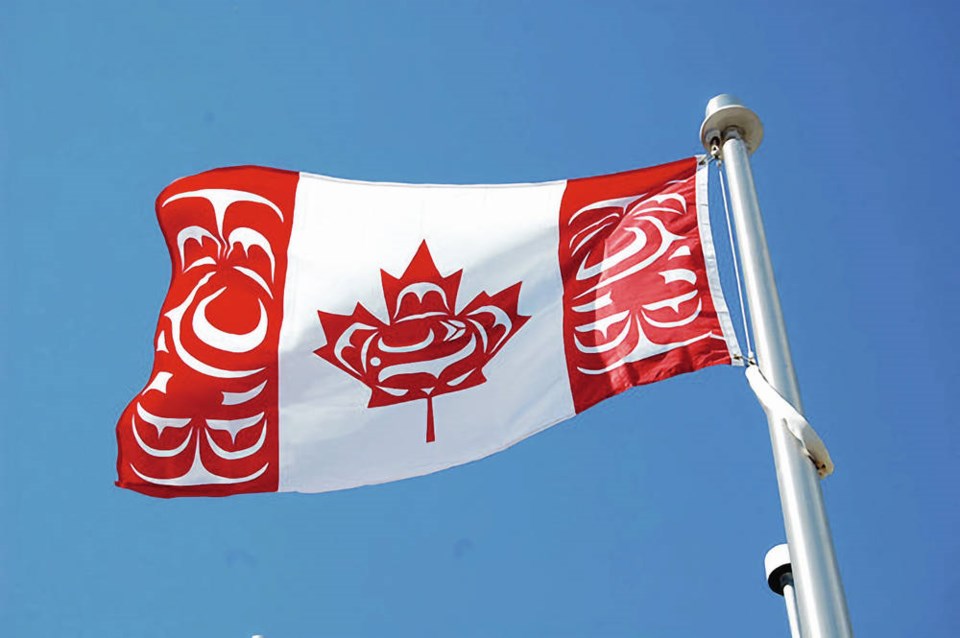Last week, the Times Colonist announced that for Canada Day, it would be running a full-page pull-out of the Canadian Indigenous Flag. Designed by the late Curtis Wilson (Mulidzas) of the Wei Wai Kum First Nation near Campbell River, it is a revised maple leaf flag with swimming salmon in the side bars and an orca in the maple leaf.
Dave Obee, the Times Colonist’s editor and publisher, commented that this flag “reflects the times we are in,” adding: “Canada, as we know it, could not exist without the Indigenous presence.” While recognizing that this is not the official flag, he said, “this year it seems like the right one.”
I agree. But why only this year, I thought. Why not adopt it as Canada’s flag? And while we are at it, why not change the name of this land we call Canada to Kanata? After all, the Government of Canada website tells us that “the name Canada likely comes from the Huron-Iroquois word “kanata,” meaning “village” or “settlement,” so it is an Indigenous name already.
Such an idea is not without precedent. Increasingly, the country we used to call New Zealand is renaming itself Aotearoa New Zealand, Aotearoa being the original Maori name for the land, often translated as “the land of the long white cloud.”
Go to the government’s website and you will find it is headlined Government of New Zealand/Te Kawanatanga o Aotearoa, and you are greeted with “Kia ora,” which means “hello” and has come to be the common greeting in Aotearoa New Zealand these days.
The Maori arrived in Aotearoa around the 13th century, populating the country — until then free of humans — only 500 years before the first Europeans arrived. As a result, and because they all came from various eastern Polynesian islands with related languages and cultures, there is only one Maori language across the entire country, although with many local dialects, as is true of English.
In 1985, Maori was recognized as a “taonga” (treasure) that the government was obliged to protect under the Treaty of Waitangi, and in 1987, it became one of the three official languages of Aotearoa New Zealand, alongside English and New Zealand Sign Language.
So it was wonderful, when I attended a large global health-promotion conference in Aotearoa New Zealand in 2019, to hear the Maori elders greet delegates from around the world in Maori, with no English translation available. They were in effect proclaiming with pride “this is our language, this is our culture, this is our land” — and so they should.
Here, of course, things are more complex. There are three main groups of Indigenous people in Canada. The First Nations (often still called “Indians”) were the first to arrive, starting some 20,000 years ago, and now comprise more than 50 Indigenous Nations and languages and over 600 communities.
According to the Canadian Encyclopedia, the Inuit arrived about 1,000 years ago — well before the first Europeans arrived 500 years ago — moving east across what is now their homeland in the Arctic, from the Bering Strait all the way to Labrador (and beyond, to Greenland). There are eight main Inuit ethnic groups and five main dialects in Inuktitut, the Inuit language.
Finally, the Canadian Encyclopedia says the Métis are people of mixed European and Indigenous ancestry and possess “a singular cultural heritage of dual origins” that first emerged in the 18th century, west of Sault Ste. Marie (although much of this is still debated).
So, as far as I know, there is no single agreed-upon Indigenous term for the land we today call Canada. But the term Kanata has an historic relationship to the modern word for the country and is an eastern Canada Indigenous term, nicely balancing the western Canada imagery on the Canadian Indigenous Flag.
I put this idea forward not as a definitive answer — for one thing, it has not had any input from Indigenous people themselves, who would be key to any such change — but in the spirit of reconciliation.
So why not start the discussion here: How should the name and flag of the country we call Canada be changed to reflect and honour the Indigenous people of this land?
thancock@uvic.ca
Dr. Trevor Hancock is a retired professor and senior scholar at the University of Victoria’s School of Public Health and Social Policy.



